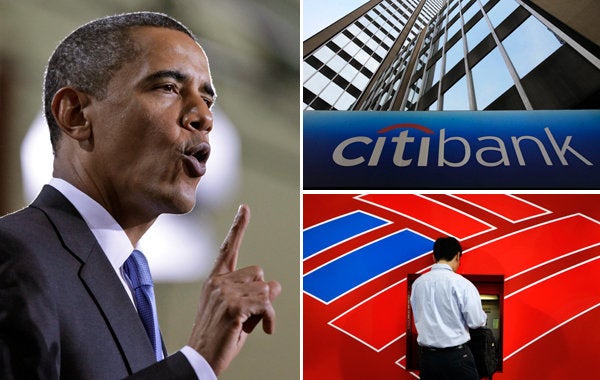
While the administration and Congress work to increase bank lending, the nation's four biggest banks have collectively cut their loans to businesses by more than $100 billion over the past six months, according to new federal data released on Tuesday.
Bank of America, JPMorgan Chase, Citigroup and Wells Fargo cut their commercial and industrial lending by a combined 15 percent from April to October, representing $100 billion, according to the most recent Treasury Department data. Loans to small businesses are down $7 billion, or four percent.
President Barack Obama announced his administration's small business lending initiative in March. As the unemployment rate hovers around 10 percent, there's been an increased push recently by the administration and members of Congress to stimulate lending to small businesses in hopes of increasing the availability of jobs. But loans to businesses by the top four banks are down $107 billion since April.
The reduced lending by the four biggest bank-holding companies, all of which are largely considered to be "too big to fail," appears to be steeper than in the overall banking sector. Over the same time period, commercial and industrial loans at all banks declined about 10.8 percent, or $166 billion, according to Federal Reserve data -- that figure includes Bank of America, Citibank, Wells Fargo and JPMorgan Chase.
Among the big four, Wells Fargo had the smallest decline at 5 percent; Citigroup had the largest at 29 percent. JPMorgan Chase cut its loans by $21 billion, or 13 percent.
Bank of America led the pack in terms of its cuts. The bank slashed commercial and industrial loans by 21 percent. Thanks to its enormous size, that translated into a $58 billion decrease -- by far the largest decline in business lending by any U.S. bank.
After Monday's meeting at the White House with Obama and the nation's top bankers, Bank of America pledged to increase lending to small- and medium-sized businesses next year by at least $5 billion.
There's no clear reason to explains big banks' decline in lending. Analysts have pointed to a number of different possibilities including decreased loan demand, a decrease in credit-worthy borrowers with sufficient collateral, cautious regulators protecting banks from potential losses and banks' need to shore up their balance sheets in anticipation of future, unrealized loan losses.
And big banks are able to generate large profits through their trading desks, enabling them to book profits without having to lend in an uncertain economic environment. After all, the banks' borrowing costs are at historic lows; for the biggest banks it's even lower. So why not roll the dice if one can borrow cheaply?
While Federal Reserve survey data and the banks themselves point to decreased demand for loans, small business advocates say the fact remains that banks are cutting back, making it even more difficult for credit-worthy businesses to secure financing.
"Lending isn't easing. It's just as difficult to get loans now as it was six months," said Molly Brogan, vice president of public affairs for the National Small Business Association, an advocacy group. "For months we've heard the administration talking about getting TARP funds to small businesses" in the form of increased bank lending. "But the proof is in the pudding. You're either going to do something about it or you can keep talking," Brogan said.
